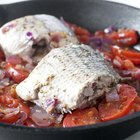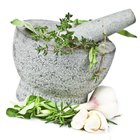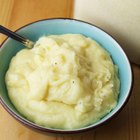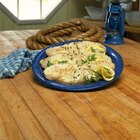A white sauce adds flavor and texture to relatively bland and dry white fishes, such as sole and cod. A plain white sauce, or one infused with wine and shallots, is classic -- but citrus, herbs and other spices can punch it up to make your dinner something special.
Classic Sauce
A classic white sauce starts with roux, a mixture of butter and flour, as a base.
In a small pot, melt about 1 tablespoon of butter over low heat. Stir in 1 tablespoon of flour, and cook for just a minute or two.
Add 1 cup of warm milk and stir with a whisk as it simmers to thoroughly incorporate the roux and eliminate any lumps. The sauce should thicken.
Season with salt and white pepper, to preserve the color, for a basic version of white sauce to serve -- or season with spices such as curry, chili powder or cayenne pepper.
Season It Up
Before adding the flour to the roux, saute a tablespoon or two of minced shallots in the butter until they're translucent. Stir in the flour to create the roux, and then add the milk along with a tablespoon of white wine. Bring it to a simmer, stirring to incorporate the roux, and serve. Add fresh herbs, such as thyme, chives or dill, to the finished sauce for more flavor.
Flavor the Milk
To create a sauce with more depth of flavor, steep a bay leaf, a whole clove and 2 to 3 whole peppercorns in the milk as it warms, before you add it to the roux. When you're ready to stir the milk into the butter and flour, remove the spices.
One-Pan Lemon Cream Sauce
Cooking the sauce in the same pan in which you cooked the fish makes for easy preparation.
Saute 3 tablespoons of butter in a frying pan over medium heat.
Dust 4 to 6 sole fillets with salt, pepper and 1/4 cup of flour, and add the fish to the pan. Cook for just about 2 minutes per side, or until it's browned and cooked through.
Remove the fish from the pan, and add about 1/4 cup of heavy cream and about 1 teaspoon of lemon zest.
Simmer to thicken the cream, just a minute or two, and then stir in a tablespoon of chopped, fresh parsley, a tablespoon of lemon juice and salt to taste.
Related Articles

How to Make French Sauce With Roux of ...

How to Cook Hog Fish

How to Make Fish Taco Sauce

How to Pan Fry Sea Bass

How to Cook Angelfish

How to Make Newburg Sauce

How to Make Clam Sauce With Chopped ...

How to Make Crab Bisque

How to Make Rosemary & Thyme Sauce

The History of Bearnaise Sauce
Homemade Cream of Mushroom Soup Recipe
Easy Indian Butter Chicken Recipe
How to Cook Chilean Sea Bass Cheeks

How to Make Cornmeal Polenta

How to Make Creamy Alfredo Sauce With ...

How to Cook Red Snapper Jamaican Style

How to Cook Moose Steaks

How to Cook Sole Fillets With Butter ...

Can You Use Milk Instead of Cream for ...

How to Cook Tilapia With Orange Juice & ...
References
Writer Bio
Andrea Cespedes is a professionally trained chef who has focused studies in nutrition. With more than 20 years of experience in the fitness industry, she coaches cycling and running and teaches Pilates and yoga. She is an American Council on Exercise-certified personal trainer, RYT-200 and has degrees from Princeton and Columbia University.